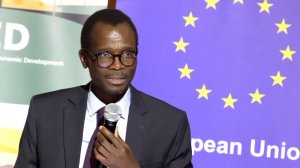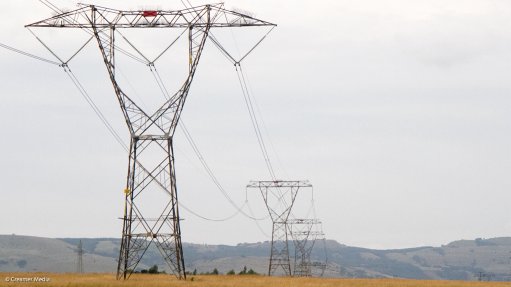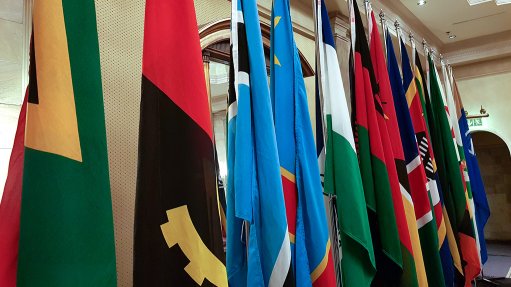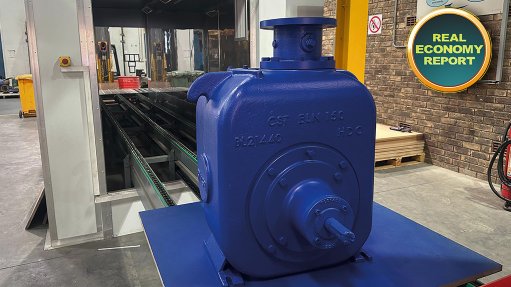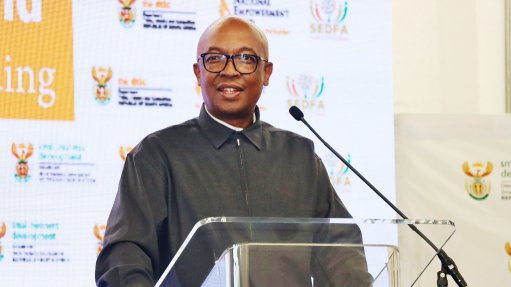Partnerships with the private sector, communities key to building climate-resilient infrastructure

Deputy Finance Minister David Masondo unpacks how government is approaching climate-resilient infrastructure financing
The African continent needs an estimated $190-billion a year to meet its climate change mitigation and energy needs transition, but 57% of countries are in debt and unable to support the amount of investment required.
These countries, therefore, need innovative finance mechanisms to advance climate-resilient infrastructure.
Deputy Finance Minister David Masondo in his keynote address during a Southern Africa Towards Inclusive Economic Development (SA-TIED) debate hosted at the University of the Witwatersrand (Wits), on March 19, said that, in South Africa’s case, government was seeking to finance this infrastructure using green bonds and carbon credits, while working with international partners on evidence-based research to inform policy direction.
“With support from international partners, we are finding the most effective ways to build a better, stronger and more sustainable South Africa.”
With infrastructure being a cornerstone in dealing with the effects of climate change, he cited South Africa’s Infrastructure Fund as an example of stimulating private investment and merging public and private resources to mitigate risks for private investors and to foster a collaborative financing model environment.
Masondo also said the leveraging of innovative technology should be treated as an opportunity for forging robust public-private partnerships and that data-driven decision-making lay at the heart of effective infrastructure planning, which was where the SA-TIED programme had continued to play a critical role.
“Research informs our policy decision-making processes, with help from partners such as the United Nations, the European Union (EU) and academic institutions.”
Masondo said climate change knew no bounds and therefore could not be tackled in an isolated manner, but required a regional and global approach, with international and cross-border partners working with each other.
He further stressed the need for investment in renewable energy sources, water systems and sustainable urban development, as the country and the continent started to feel the impacts of climate change through more natural disasters and extreme weather events.
Ambassador of the EU to South Africa Sandra Kramer in her keynote address at the SA-TIED debate agreed that the challenges of climate change, inequality and erosion of democracy were being experienced at a global level and noted that the responses to these challenges would shape the lives of generations to come.
She emphasised the need for long-term solutions across disciplines and between countries, all based on science and data.
Kramer highlighted that public finance was increasingly being used as a catalyst to leverage funding from development banks and the private sector. She added that banks were increasingly investing in projects that were transformational in countries and communities.
For example, the EU’s technical infrastructure agency at the National Treasury in South Africa helps with capacity building and boosting innovation.
Kramer said the EU was also deepening its collaboration on sustainable finance in other countries, including through its global green bond initiative, which has allocated €1-billion to derisk investments in developing markets.
EVIDENCE-BASED POLICY
The SA-TIED programme comprises government authorities and academic institutions such as Wits, which work together to close knowledge gaps, which is crucial to the achievement of inclusive growth and economic transformation, including in the context of climate change.
Through SA-TIED, researchers have access to comprehensive anonymised tax data made available by South Africa’s National Treasury and supported by the United Nations University World Institute for Development Economics Research.
National Treasury environmental economics director and SA-TIED workstream co-lead Georgina Ryan said the water, energy and food nexus workstream – one of six workstreams across the macroeconomy that form part of the SA-TIED programme – was aimed at developing a model relevant for South Africa’s economy, which could track financial flows in terms of climate change.
This workstream is also identifying the investments required in the water and energy sectors and by when, to ensure timely investments in the next decade.
Ryan emphasised the need for timely investments to set the foundation for adapting to climate change and to mitigate the escalation of costs owing to inaction.
An SA-TIED report on investment required in the water sector has been published on its website, while the energy report is still being finalised.
EXPERT COMMENTARY
Speaking in a panel discussion as part of the SA-TIED debate, Western Cape Economic Development Partnership CEO Nishendra Moodley said incoming infrastructure builds needed not only to be climate-resilient but should also aid the region against the effects of climate change.
He agreed with Masondo that the fiscus alone could not fund all the infrastructure that was required and that the City of Cape Town, for example, had managed to build a R55-billion pipeline of infrastructure projects with the help of the private sector.
About 40% of these projects will contribute to climate change mitigation.
He highlighted the importance of understanding who is vulnerable in every investment decision and to choose what is most equitable, as well as create an early sense of involvement and potentially ownership models for some of these developments.
Public interest law centre Section27 budget policy analyst and researcher Matshidiso Lencoasa echoed this sentiment, stating that despite the “democratic transition” having occurred 30 years ago, many legacy issues, such as inequality and unemployment, were still entrenched.
To avoid having another inequitable transition, more creative solutions were required, including for financing, she added.
Lencoasa said policy ought to put the lived experience of people at the forefront, instead of making some sort of trade-off between economic and societal development. “We need both, lest we risk moving forward by surviving climate change at the expense of people that are left vulnerable.”
She also agreed with Moodley that climate deals should be shaped by the intended beneficiaries.
Consultancy Ernst and Young Africa chief economist Angelika Goliger said the work undertaken by SA-TIED was a good start in undertaking climate risk assessments, which should, in turn, inform integrated planning.
“Quantifying the impact is essential. Corporates are moving from simply reporting on climate change to understanding the impact and outcomes that need to be achieved, and what metrics need to be measured,” she stated, emphasising the need for continuing monitoring and modification throughout a project lifecycle.
Goliger pointed out that companies that had better integrated sustainability had proven to earn higher financial returns.
She also agreed on the importance of involving communities in infrastructure investment, particularly to understand the local context and demographic makeup in an area.
Financial services provider FirstRand financial sector policy strategy head Avril Halstead said that, with the water sector requiring R25-billion a year for maintenance and for adequate capital expenditure, and many municipalities in the country being in financial distress, capacity building was a key area that required work if investment was to be garnered from the private sector.
She highlighted that municipalities often did not know what a bankable project involved, hence the need for private sector assistance to close those financial viability gaps.
Government Technical Advisory Centre infrastructure advisory head Boitumelo Mashilo stressed the need for mainstream climate finance in the country’s infrastructure approach, adding that environmental issues could not be an add-on feature or an afterthought.
He agreed with Moodley on the importance of a credible development pipeline for creating impact. Mashilo cited the example of a power station not being valuable for its inherent value, but for the services it enables.
Mashilo also emphasised the importance of public-private partnerships, as not one agency in the economy should be responsible for climate change mitigation.
He echoed the sentiments of Halstead that the State did not have the capacity and expertise to efficiently deliver on climate-resilient infrastructure projects and maintenance alone, nor to deal with the prevailing construction mafia that posed a threat to new developments.
Consultancy Zutari technical director and water resource engineer Dr James Cullis agreed that, in many ways, the country had the required planning and technology for climate-resilient infrastructure but implementation was lacking owing to State incapacity in many instances.
He stressed the need for regional integration, citing the Lesotho Highlands water system as an example, to ensure climate resilience for South Africa, particularly if local infrastructure was not being maintained adequately.
“The question of capital is not necessarily if we can afford to pay for it, but can we afford not to pay for it,” he stated, referring to ecological infrastructure investment such as water conservation.
Cullis concluded that there could never be a perfect decision with an infrastructure or climate change approach, stating that the ability to adjust as you go along was key.
Article Enquiry
Email Article
Save Article
Feedback
To advertise email advertising@creamermedia.co.za or click here
Comments
Press Office
Announcements
What's On
Subscribe to improve your user experience...
Option 1 (equivalent of R125 a month):
Receive a weekly copy of Creamer Media's Engineering News & Mining Weekly magazine
(print copy for those in South Africa and e-magazine for those outside of South Africa)
Receive daily email newsletters
Access to full search results
Access archive of magazine back copies
Access to Projects in Progress
Access to ONE Research Report of your choice in PDF format
Option 2 (equivalent of R375 a month):
All benefits from Option 1
PLUS
Access to Creamer Media's Research Channel Africa for ALL Research Reports, in PDF format, on various industrial and mining sectors
including Electricity; Water; Energy Transition; Hydrogen; Roads, Rail and Ports; Coal; Gold; Platinum; Battery Metals; etc.
Already a subscriber?
Forgotten your password?
Receive weekly copy of Creamer Media's Engineering News & Mining Weekly magazine (print copy for those in South Africa and e-magazine for those outside of South Africa)
➕
Recieve daily email newsletters
➕
Access to full search results
➕
Access archive of magazine back copies
➕
Access to Projects in Progress
➕
Access to ONE Research Report of your choice in PDF format
RESEARCH CHANNEL AFRICA
R4500 (equivalent of R375 a month)
SUBSCRIBEAll benefits from Option 1
➕
Access to Creamer Media's Research Channel Africa for ALL Research Reports on various industrial and mining sectors, in PDF format, including on:
Electricity
➕
Water
➕
Energy Transition
➕
Hydrogen
➕
Roads, Rail and Ports
➕
Coal
➕
Gold
➕
Platinum
➕
Battery Metals
➕
etc.
Receive all benefits from Option 1 or Option 2 delivered to numerous people at your company
➕
Multiple User names and Passwords for simultaneous log-ins
➕
Intranet integration access to all in your organisation


